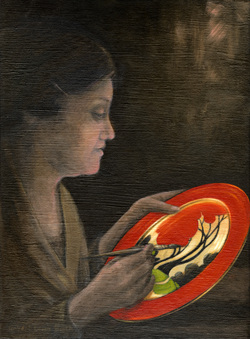Portrait of Miss Clarice Cliff by Robert lewis Booth
Clarice Cliff an English ceramic industrial artist.

I’ve kept her portrait in subdued colours while placing emphasis on the plate
Dated 2004
Oil on canvas panel Size 16”x 12”
403 x 305
The following text taken from Wikipedia encyclopedia
Clarice Cliff (January 20 1899 – October 23, 1972) was an English Ceramic industrial artist.
She was born in January 1899 in Tunstall, Stoke-on-Trent England, the fourth of eight children and the daughter of Harry Thomas Cliff an iron-moulder and Ann Machin.
Clarice started working at the age of 13 as an apprentice enameller. At 17 she joined A. J. Wilkinson's Royal Staffordshire Pottery as a lithographer. Her drawing ability was soon noticed and she attended evening classes at Burslem School of Art from 1924-1925 and studied sculpture at the Royal College of Art in 1927, but returned after only a few months to set up a small studio in Wilkinson's Newport Pottery, decorating traditional white-ware.
She covered the imperfections in simple patterns of triangles, vividly coloured in a style that was to become known as 'Original Bizarre'. To the surprise of the company's salesmen, this was immediately popular. She was provided with her own studio and another paintress to assist, but this rapidly expanded to a team of around 70 young painters, mainly women but four boys - they hand painted the wares under her direction.
The enthusiasm which greeted Bizarre generated a burst of creative activity. By 1931 Miss Cliff was supervising a workforce of up to 1000 at the Newport Pottery, with 150 boys and girls trained in the decorating shop, producing new modern shapes and designs. Through the depths of the Depression her wares continued to sell in volume at what were high prices for the time. Her Bizarre ware was sold throughout the world, North America, Australia, New Zealand, South Africa, but not in mainland Europe. In Britain many top London stores sold it, including Harrods.
In 1930 she was appointed Art Director to Newport Pottery and A. J. Wilkinson's, the two adjoining factories that produced her wares. Her work involved spending more time with the factory owner Colley Shorter, and this gradually developed into an affair, conducted in secrecy. In 1940, after the death of Ann Shorter, Colley's wife, they married and Clarice moved into the Shorter home at Chetwynd House.
During World War Two only plain white pottery was permitted under wartime regulations, so Clarice assisted with management of the pottery but was not able to continue design work.
Wartime restrictions on decorated pottery were to continue into the 1950's and the factory was never to produce pottery in the style or quantity of the pre-war period. Much of the design work was to pass into other hands, with Clarice and Colley spending less time at the factory and more time travelling and promoting the wares of A. J. Wilkinson.
In 1961, Colley was to fall ill and he died in 1963. Clarice Cliff decided the time had come to retire and the factory sites were sold in August 1964 to Midwinter's, thus ceasing the production of all original Clarice Cliff wares. With the factory site sold, there was to be no successor to Clarice Cliff and the production of original Clarice Cliff ended.
In 1971, Clarice Cliff was acknowledged as a major art deco designer by the Minneapolis Institute of Arts, when a large number of her pieces were included in their influential World of Art Deco Exhibition. With interest rising in her pre-war work, later in 1971, Miss Cliff was persuaded to write her own memoirs. Sadly age had started to affect her memory and some of the information Miss Cliff wrote is we now know inaccurate.
In October 1972, Miss Cliff died at Chetwynd House, her home since 1940. She was found by her gardener sitting in her favourite chair listening to the radio.
W.R. Midwinter's merged with Meakins in 1968, who in turn were absorbed by the Wedgwood group in 1970. The factory sites have now been redeveloped for housing.